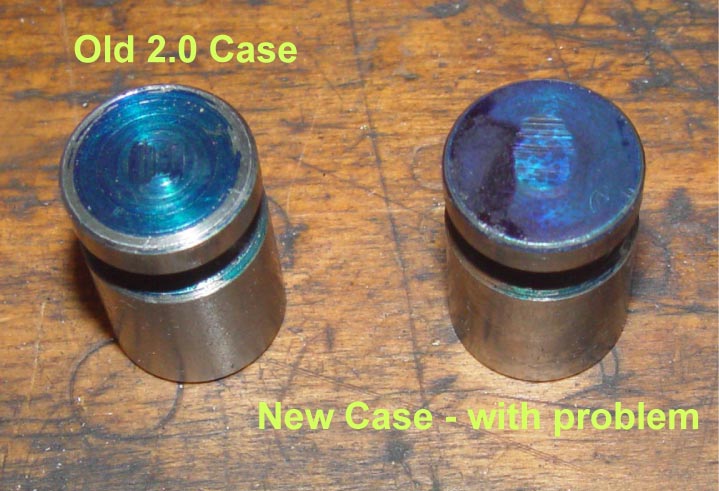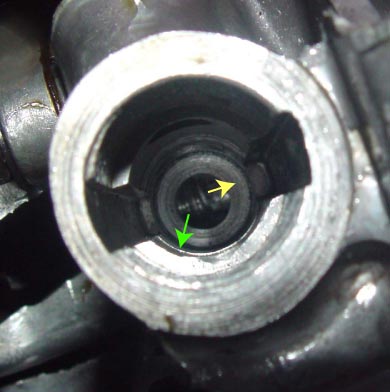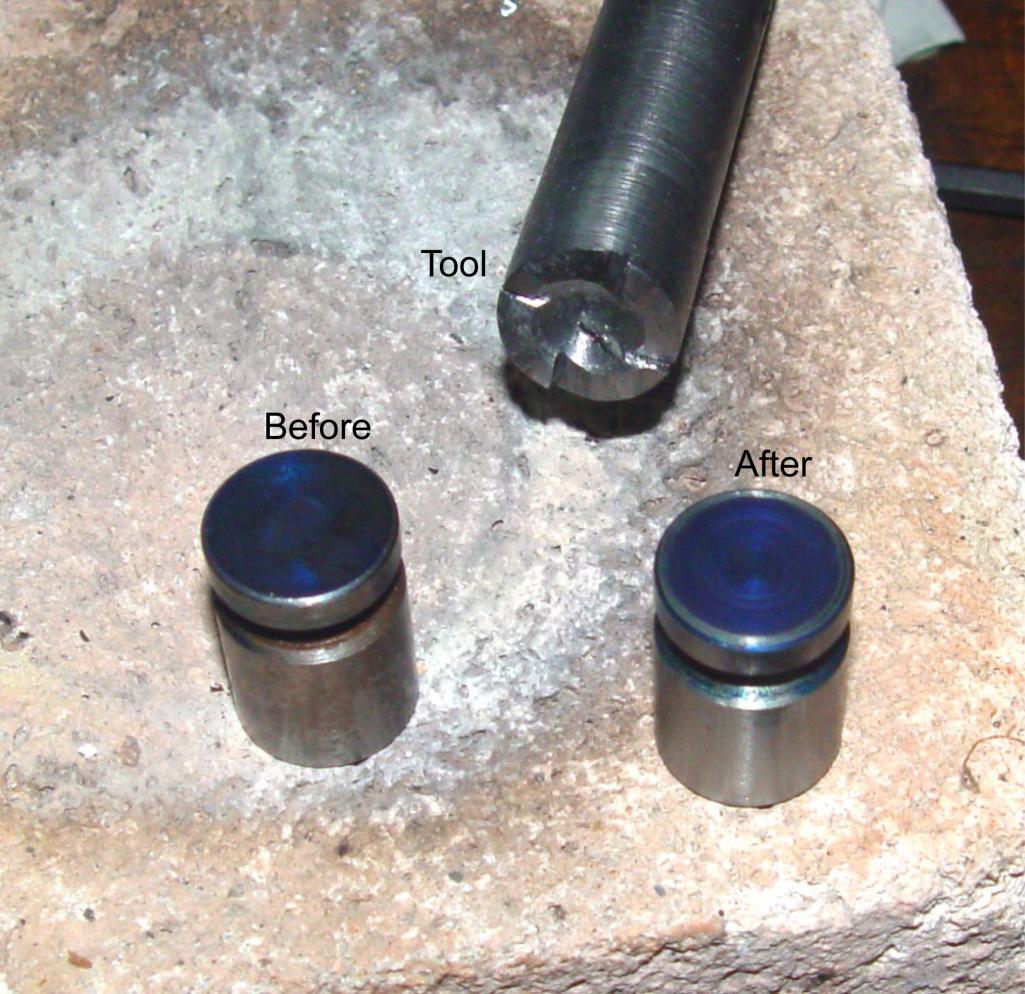|
|

|
Porsche, and the Porsche crest are registered trademarks of Dr. Ing. h.c. F. Porsche AG.
This site is not affiliated with Porsche in any way. Its only purpose is to provide an online forum for car enthusiasts. All other trademarks are property of their respective owners. |
|
|
| worn |
 May 13 2013, 08:33 AM May 13 2013, 08:33 AM
Post
#1
|
|
Winner of the Utah Twisted Joint Award     Group: Members Posts: 3,466 Joined: 3-June 11 From: Madison, WI Member No.: 13,152 Region Association: Upper MidWest 
|
If anyone has read my previous threads my two week vacation turned from driving to lying on the creeper under the new engine and transmission. Low oil pressure after warm up. I ordered a new Melling 30 mm pump and we shall see, but at the same time I looked into the pressure relief system - especially where it shunts oil away from the cooler because it is easier to see in the car.
What I found surprised me. First, looking at two different cases (72 1.7 and 76 2.0) I found that the piston seats on a shoulder in the bore that is at most a mm wide, and is not at all uniform in width across the piston face. OK, maybe it isn't supposed to seal. Second I found that by the time you have opened the valve to shunt past the cooler, you are also dumping into the sump. That is there is a small overlap between the outlet to the oil gallery and the grooves cut in the bore leading to the sump exit. Finally, the piston is simply loose in the bore. I can understand a fear of seizing, but there is no way that with my system oil isn't streaming into the sump, and it will stream faster as it thins - much faster. I also spent a long time cruising the Samba - they ought to know whats up. What I found is a recurrent theme of new engines built in a variety of ways making low oil pressure. Many people were happy with what I ended up with - 10 psi at idle. On a new engine. It is steel against untreated aluminum, so wear would be expected, but mine do not look worn - just poorly made. Maybe they are worn and I cannot tell. I got a face full of oil on one attempt at examination, so I may have missed things. It seems an ideal situation for machining or sleeving during the rebuild, and I actually found a manufacturer of a sleeving kit with a ball bearing valve. Thoughts ladies and gentlemen? (IMG:style_emoticons/default/idea.gif) |
  |
Replies
| r_towle |
 May 15 2013, 09:46 PM May 15 2013, 09:46 PM
Post
#2
|
|
Custom Member                Group: Members Posts: 24,705 Joined: 9-January 03 From: Taxachusetts Member No.: 124 Region Association: North East States 
|
Please post some pics of what you are doing.
|
| worn |
 May 16 2013, 08:44 AM May 16 2013, 08:44 AM
Post
#3
|
|
Winner of the Utah Twisted Joint Award     Group: Members Posts: 3,466 Joined: 3-June 11 From: Madison, WI Member No.: 13,152 Region Association: Upper MidWest 
|
Please post some pics of what you are doing. OK, I am making some progress. If the bearings are loose, this will be a bit of an extra, but that hasn't been tested yet. It is hard to show, but here is what I found: The first image shows a comparison between the Prussian blue rub off in my old worn out 2.0 and the new 2056. The pistons are identical.  You can see a clear seat in the old, but you can hardly see contact with the new. In fact, there is a small rim around the chamfer where dye has transferred. OK, getting a photo of the cylinder was tough. Here is my best and it shows the problem:  The green arrow shows the offending ridge running all round the circumference of the cylinder. A slightly smaller final bore perhaps? At any rate, that is what stops the piston a couple of mm short of the seat. the line between the pressure bevel and what is supposed to be the seat is shown with the other arrow. What I did was to get a piece of scrap iron. It should have been steel - I made a bad choice based on what was lying around and made a cutter at 15.9 mm. It is shown below with a before and after prussian blue test. I used grease to catch the swarf, which in my case was a very fine powder - like anti seize. At first I thought this would go quick, but it took quite a lot of turning the tool because basically the tool I made is not at all aggressive - it dulls fast and there was purposely no relief cut for the cutters.  I have to rinse well, clean like the dickens and get it back off the stands to find out how things go. Since I changed two variables at once with the new pump, I will never know. What I can say is any oil that gets by the piston is back to the sump. The bores tend to wear and there is nothing to stop it but viscosity at the valve. So if as I suspect the valve wasn't sealing, I would expect what I found. Low pressure with hot oil. |
| 0396 |
 May 20 2013, 10:16 AM May 20 2013, 10:16 AM
Post
#4
|
|
Advanced Member     Group: Members Posts: 2,046 Joined: 13-October 03 From: L.A. Calif Member No.: 1,245 Region Association: Southern California |
Please post some pics of what you are doing. OK, I am making some progress. If the bearings are loose, this will be a bit of an extra, but that hasn't been tested yet. It is hard to show, but here is what I found: The first image shows a comparison between the Prussian blue rub off in my old worn out 2.0 and the new 2056. The pistons are identical.  You can see a clear seat in the old, but you can hardly see contact with the new. In fact, there is a small rim around the chamfer where dye has transferred. OK, getting a photo of the cylinder was tough. Here is my best and it shows the problem:  The green arrow shows the offending ridge running all round the circumference of the cylinder. A slightly smaller final bore perhaps? At any rate, that is what stops the piston a couple of mm short of the seat. the line between the pressure bevel and what is supposed to be the seat is shown with the other arrow. What I did was to get a piece of scrap iron. It should have been steel - I made a bad choice based on what was lying around and made a cutter at 15.9 mm. It is shown below with a before and after prussian blue test. I used grease to catch the swarf, which in my case was a very fine powder - like anti seize. At first I thought this would go quick, but it took quite a lot of turning the tool because basically the tool I made is not at all aggressive - it dulls fast and there was purposely no relief cut for the cutters.  I have to rinse well, clean like the dickens and get it back off the stands to find out how things go. Since I changed two variables at once with the new pump, I will never know. What I can say is any oil that gets by the piston is back to the sump. The bores tend to wear and there is nothing to stop it but viscosity at the valve. So if as I suspect the valve wasn't sealing, I would expect what I found. Low pressure with hot oil. Pm sent on tool. Thanks |
Posts in this topic
 worn Relief May 13 2013, 08:33 AM
worn Relief May 13 2013, 08:33 AM
 reharvey I've been following your posts about the oil p... May 13 2013, 08:57 AM
reharvey I've been following your posts about the oil p... May 13 2013, 08:57 AM

 worn
I've been following your posts about the oil ... May 13 2013, 09:33 AM
worn
I've been following your posts about the oil ... May 13 2013, 09:33 AM

 worn
I've been following your posts about the oil ... May 13 2013, 01:28 PM
worn
I've been following your posts about the oil ... May 13 2013, 01:28 PM

 reharvey
I've been following your posts about the oil... May 14 2013, 03:28 PM
reharvey
I've been following your posts about the oil... May 14 2013, 03:28 PM

 worn
[quote name='worn' post='1863422' date='May 13 20... May 14 2013, 03:39 PM
worn
[quote name='worn' post='1863422' date='May 13 20... May 14 2013, 03:39 PM
 Cap'n Krusty How is a larger oil pump, which will definitely in... May 13 2013, 09:20 AM
Cap'n Krusty How is a larger oil pump, which will definitely in... May 13 2013, 09:20 AM

 worn
How is a larger oil pump, which will definitely i... May 14 2013, 12:56 PM
worn
How is a larger oil pump, which will definitely i... May 14 2013, 12:56 PM
 worn Here is a drawing about what it looks like. Sorry... May 13 2013, 09:22 AM
worn Here is a drawing about what it looks like. Sorry... May 13 2013, 09:22 AM
 FourBlades Keep in mind this is just a guess...
The oil pres... May 13 2013, 09:22 AM
FourBlades Keep in mind this is just a guess...
The oil pres... May 13 2013, 09:22 AM
 nathansnathan I've experienced this same thing, low oil pres... May 13 2013, 09:24 AM
nathansnathan I've experienced this same thing, low oil pres... May 13 2013, 09:24 AM

 worn Yeah Nathan, I looked at that site too. I am way... May 13 2013, 09:38 AM
worn Yeah Nathan, I looked at that site too. I am way... May 13 2013, 09:38 AM
 r_towle Check the case main bearing seat size.
Check the m... May 14 2013, 02:33 PM
r_towle Check the case main bearing seat size.
Check the m... May 14 2013, 02:33 PM

 worn
Check the case main bearing seat size.
Check the ... May 14 2013, 02:49 PM
worn
Check the case main bearing seat size.
Check the ... May 14 2013, 02:49 PM

 r_towle
[quote name='r_towle' post='1863940' date='May 14... May 14 2013, 03:44 PM
r_towle
[quote name='r_towle' post='1863940' date='May 14... May 14 2013, 03:44 PM

 worn
[quote name='r_towle' post='1863940' date='May 1... May 14 2013, 09:16 PM
worn
[quote name='r_towle' post='1863940' date='May 1... May 14 2013, 09:16 PM

 r_towle
[quote name='r_towle' post='1863972' date='May 14... May 15 2013, 07:17 AM
r_towle
[quote name='r_towle' post='1863972' date='May 14... May 15 2013, 07:17 AM

 worn
So, now what are you planning to do?
Not sure I ... May 15 2013, 12:08 PM
worn
So, now what are you planning to do?
Not sure I ... May 15 2013, 12:08 PM
 eyesright FWIW I'm just now rereading the Haynes manual,... May 14 2013, 02:33 PM
eyesright FWIW I'm just now rereading the Haynes manual,... May 14 2013, 02:33 PM

 worn
FWIW I'm just now rereading the Haynes manual... May 14 2013, 03:00 PM
worn
FWIW I'm just now rereading the Haynes manual... May 14 2013, 03:00 PM
 yeahmag Interesting for sure:
http://www.headflowmasters.... May 14 2013, 03:14 PM
yeahmag Interesting for sure:
http://www.headflowmasters.... May 14 2013, 03:14 PM
 cary Did you get a case yet?
I have one that had a hol... May 15 2013, 06:00 AM
cary Did you get a case yet?
I have one that had a hol... May 15 2013, 06:00 AM

 nathansnathan aircooled.net used to rent out a 5/8" end mil... May 16 2013, 09:05 AM
nathansnathan aircooled.net used to rent out a 5/8" end mil... May 16 2013, 09:05 AM


 worn
aircooled.net used to rent out a 5/8" end mi... May 16 2013, 09:24 AM
worn
aircooled.net used to rent out a 5/8" end mi... May 16 2013, 09:24 AM
 FourBlades :popcorn: :popcorn: :popcorn:
You have done a ... May 16 2013, 01:21 PM
FourBlades :popcorn: :popcorn: :popcorn:
You have done a ... May 16 2013, 01:21 PM
 brant This is what I described in your other thread
it m... May 16 2013, 01:59 PM
brant This is what I described in your other thread
it m... May 16 2013, 01:59 PM
 yeahmag Just to refresh my memory, you are trying to get m... May 16 2013, 02:08 PM
yeahmag Just to refresh my memory, you are trying to get m... May 16 2013, 02:08 PM
 r_towle Interesting.
Might be worth getting a custom pisto... May 16 2013, 04:52 PM
r_towle Interesting.
Might be worth getting a custom pisto... May 16 2013, 04:52 PM
 Jake Raby All these rules and myths change when bearing clea... May 16 2013, 09:31 PM
Jake Raby All these rules and myths change when bearing clea... May 16 2013, 09:31 PM

 worn
All these rules and myths change when bearing cle... May 17 2013, 09:10 PM
worn
All these rules and myths change when bearing cle... May 17 2013, 09:10 PM

 nathansnathan
What I think is interesting is we have numbers fo... May 18 2013, 06:53 AM
nathansnathan
What I think is interesting is we have numbers fo... May 18 2013, 06:53 AM

 worn
What I think is interesting is we have numbers f... May 19 2013, 08:53 PM
worn
What I think is interesting is we have numbers f... May 19 2013, 08:53 PM

 worn
[quote name='nathansnathan' post='1865830' date='... May 19 2013, 08:57 PM
worn
[quote name='nathansnathan' post='1865830' date='... May 19 2013, 08:57 PM

 cary I learned another lesson as well. You cannot tune ... May 19 2013, 10:29 PM
cary I learned another lesson as well. You cannot tune ... May 19 2013, 10:29 PM

 worn
[color=#330099][i]I learned another lesson as wel... May 20 2013, 08:41 AM
worn
[color=#330099][i]I learned another lesson as wel... May 20 2013, 08:41 AM
 yeahmag So you went from 10PSI to 20PSI at idle with all t... May 19 2013, 09:23 PM
yeahmag So you went from 10PSI to 20PSI at idle with all t... May 19 2013, 09:23 PM

 worn
So you went from 10PSI to 20PSI at idle with all ... May 20 2013, 08:45 AM
worn
So you went from 10PSI to 20PSI at idle with all ... May 20 2013, 08:45 AM

 r_towle
So you went from 10PSI to 20PSI at idle with all... May 25 2013, 11:49 AM
r_towle
So you went from 10PSI to 20PSI at idle with all... May 25 2013, 11:49 AM

 worn
[quote name='worn' post='1866719' date='May 20 20... May 26 2013, 09:13 AM
worn
[quote name='worn' post='1866719' date='May 20 20... May 26 2013, 09:13 AM

 r_towle
[quote name='worn' post='1866719' date='May 20 2... May 26 2013, 02:30 PM
r_towle
[quote name='worn' post='1866719' date='May 20 2... May 26 2013, 02:30 PM
 396 Sub as its very interesting read.
After reading t... May 19 2013, 10:09 PM
396 Sub as its very interesting read.
After reading t... May 19 2013, 10:09 PM
 eyesright My (home rebuild) engine is back in the car, oil l... May 20 2013, 10:01 AM
eyesright My (home rebuild) engine is back in the car, oil l... May 20 2013, 10:01 AM
 eyesright Warn
I located the relief valve seat by looking u... May 25 2013, 06:49 PM
eyesright Warn
I located the relief valve seat by looking u... May 25 2013, 06:49 PM
 76-914 Verify your "cheap gages" or you'll ... May 26 2013, 07:53 AM
76-914 Verify your "cheap gages" or you'll ... May 26 2013, 07:53 AM
 yeahmag The VDO CHT is not temp compensated. You have to d... May 26 2013, 09:44 AM
yeahmag The VDO CHT is not temp compensated. You have to d... May 26 2013, 09:44 AM
 eyesright worn
I agree with yeahmag. My VDO CHT shows 350F.... May 26 2013, 03:19 PM
eyesright worn
I agree with yeahmag. My VDO CHT shows 350F.... May 26 2013, 03:19 PM
 eyesright PS Worn, oh yeah, one more thing. When you open th... May 26 2013, 04:35 PM
eyesright PS Worn, oh yeah, one more thing. When you open th... May 26 2013, 04:35 PM  |
8 User(s) are reading this topic (8 Guests and 0 Anonymous Users)
0 Members:

|
Lo-Fi Version | Time is now: 11th April 2025 - 08:03 PM |
Invision Power Board
v9.1.4 © 2025 IPS, Inc.








